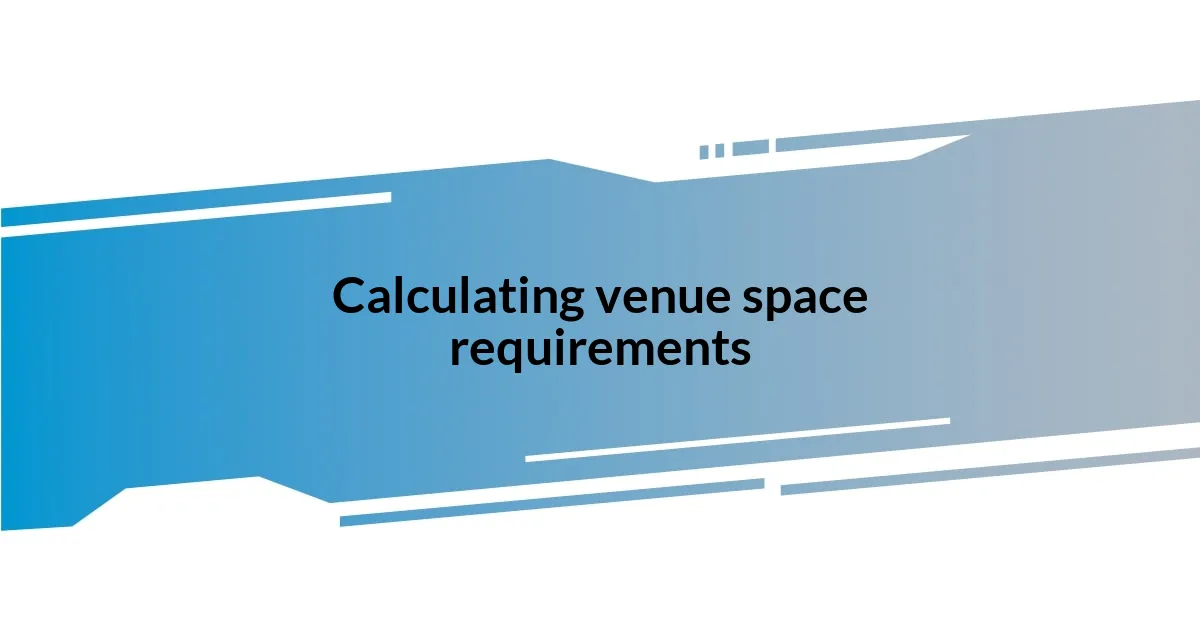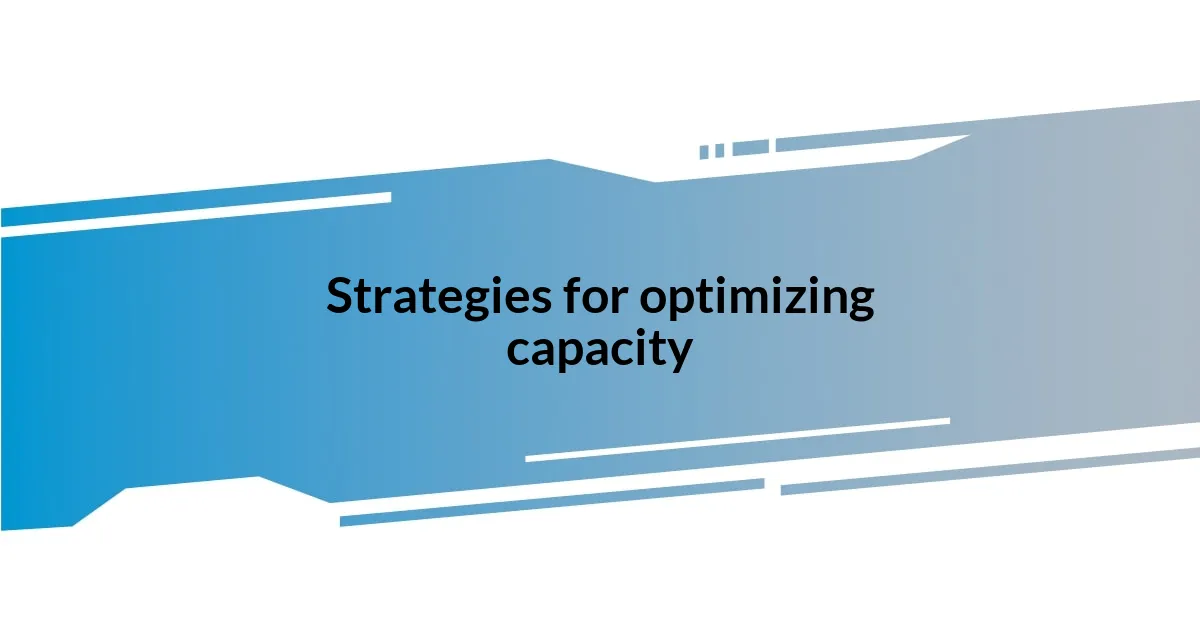Key takeaways:
- Understanding venue capacity is crucial for creating the desired atmosphere at events and ensuring attendee comfort.
- Key factors influencing capacity include event purpose, layout design, and adherence to safety regulations.
- Optimizing space involves flexibility in seating arrangements, leveraging technology for crowd management, and visualizing the attendee journey.
- Future trends in venue planning focus on hybrid events, sustainability, and wellness to enhance participant engagement and experience.

Understanding venue capacity needs
Understanding venue capacity needs goes beyond just numbers; it’s about creating the right atmosphere for your event. I’ll never forget the time I attended a wedding where the venue felt cramped and the guests were bumping elbows. It struck me how important it is to align capacity with the experience you want to deliver. Have you ever felt overwhelmed at an event? Too many people can lead to discomfort, diminishing the overall experience.
When assessing venue capacity, consider the purpose of your gathering. For instance, if it’s a networking event, a spacious layout fosters interaction and conversation. I recall a business conference I went to where the venue was purposefully designed with open spaces, allowing for effortless networking. It felt intentional, and I left feeling connected. How does your venue choice shape the kind of interactions you hope to have?
It’s crucial to account for factors like seating arrangements and flow of movement. An eclectic mix of seating can influence how people engage with one another and the content presented. I once attended a panel discussion in a venue where the seats were too tightly packed, leading to a distracted audience. It’s all about striking that balance—are you providing ample space for comfort while still encouraging mingling? Ultimately, understanding venue capacity needs is key to elevating attendees’ experiences.

Key factors influencing capacity
When I think about the key factors influencing venue capacity, I often reflect on the type of event being hosted. For example, I once organized a charity gala where the atmosphere was everything. We aimed for intimacy while accommodating a substantial number of guests. Striking that balance meant determining how close people should be to retain a sense of connection without feeling overcrowded.
The layout is another critical aspect to consider. I attended a concert in a venue with a great design that allowed for easy movement, enhancing the interactive nature of the experience. It reminded me that the right setup can transform a rigid environment into one that is more welcoming, prompting spontaneous conversations and connections. What layout will foster the atmosphere you’re aiming for at your event?
Lastly, I cannot overlook the impact of local regulations and fire codes. These guidelines not only dictate maximum capacity but also ensure safety. I was reminded of this once when a fire marshal made a last-minute adjustment to our guest count at an event, emphasizing the importance of compliance. How do you plan to navigate these regulations while still creating a lively atmosphere?
| Factor | Importance |
|---|---|
| Event Purpose | Determines the necessary space for interaction and engagement |
| Layout and Design | Influences attendee comfort and the natural flow of movement |
| Safety Regulations | Sets legal limits, ensuring a safe environment |

Assessing event types and sizes
When assessing event types and sizes, it’s essential to recognize how different gatherings create distinct demands for space. Picture the atmosphere of a lively networking mixer versus an intimate birthday party. I once attended a launch party that was buzzing with energy, and it was clear that the venue’s open design encouraged mingling. In contrast, I remember a small family reunion where too many chairs created a stuffy vibe. The contrast highlighted how the type of event directly influences the ideal venue capacity.
- Networking Events: Spacious layouts invite interaction, allowing attendees to engage freely.
- Social Gatherings: More personal settings may require closer seating for intimacy and connection.
- Formal Events: A more dignified arrangement can dictate the need for an elegant yet spacious venue.
- Workshops or Seminars: These require enough room not just for seating but also for engagement activities, fostering a conducive environment for learning.
Beyond just the number of guests, the emotional tone of your event is also tied to its type and size. I once participated in a panel discussion where the urgent need for dialogue made the space feel cramped. The energy in the room quickly shifted from excitement to frustration because of the layout. Understanding these nuances can help ensure that the venue aligns with the atmosphere you wish to evoke. A positive event experience often starts with a careful assessment of the type and size needs linked to the specific purpose of the gathering.

Calculating venue space requirements
When calculating venue space requirements, I like to reflect on the number of attendees and how they will interact with each other. For instance, I once planned a team-building event where the goal was to foster collaboration and trust. By providing ample space for breakout sessions, we encouraged participants to engage in meaningful discussions, which resulted in a more productive day. What’s your strategy for ensuring that your guests can connect comfortably?
It’s also essential to think about the furniture and equipment you’ll need. I remember a workshop that had only standard row seating; it barely encouraged any interaction. Consequently, the energy in the room was flat. A layout with movable tables and chairs enabled a different experience in another session I organized, allowing attendees to gather in smaller groups, sparking vibrant conversations. How can the arrangement of furniture enhance the engagement at your event?
Moreover, I find it crucial to consider the additional space needed for amenities. At a recent charity auction, we allocated space not just for attendees but for a silent auction setup. This thoughtful approach enhanced the guest experience, encouraging them to move around freely without feeling cramped. Have you thought about how the inclusion of such elements could impact your overall space requirements?

Strategies for optimizing capacity
When it comes to optimizing venue capacity, I believe flexibility is key. A memorable experience I had was at a conference where the organizers opted for a modular setup. The adaptable seating arrangements easily accommodated various breakout sessions throughout the day, keeping the energy fresh and engaging. Have you ever considered how different seating configurations might enhance attendee interactions at your events?
Another strategy that works wonders is utilizing technology for crowd management. I remember when a venue incorporated an app for real-time capacity updates during a festival. Attendees could use it to see which areas were busy and which were more open, leading to a smoother flow. How could technology help you manage the space better and improve guest satisfaction?
Finally, I always advocate for visualizing the attendee journey. During a charity gala I attended, the layout was carefully planned to guide guests through each phase of the event—starting with mingling, then dining, and finally the auction. This thoughtful design not only optimized capacity but also enhanced the overall experience. Have you mapped out your guests’ paths to ensure they feel comfortable and engaged throughout the event?

Managing safety and comfort
Managing safety and comfort is one of the most vital aspects of any event I plan. For instance, during a local community fair I helped organize, we had to assess not just how many people could fit in a space but also how they could safely navigate it. I learned that clear pathways and emergency exits are essential; we even marked these with colorful signs, making it visually appealing while also practical. How do you ensure that safety measures blend seamlessly into your event’s design?
In my experience, I’ve discovered that comfort extends beyond just physical space; it encompasses the overall sensory environment as well. At a wedding I attended, the venue was stunning, but the temperature was uncomfortably warm. People were fanning themselves, which detracted from the joy of the celebration. I’ve since made it a point to always check the climate control settings at venues to ensure a comfortable atmosphere. Have you done something similar to enhance the comfort levels at your events?
Moreover, I can’t emphasize enough the importance of communicating safety protocols to guests. At a corporate retreat I once organized, we implemented a simple but effective strategy: Before the event began, we held a brief orientation where we explained evacuation routes and COVID-19 safety measures. This not only put attendees at ease, but also fostered a sense of trust. How do you communicate safety measures to make guests feel more secure and comfortable during your events?

Future trends in venue planning
As I look ahead to future trends in venue planning, I’m excited about the rise of hybrid events. I recently attended a seminar where they seamlessly integrated in-person attendees with those joining remotely. The energy in the room was electric, but the online interactions were just as lively, creating a truly inclusive atmosphere. Have you thought about how you can embrace both formats to expand your event’s reach?
Sustainability is also becoming a pivotal aspect of venue planning. I once volunteered at an eco-friendly festival where everything, from the seating to the catering, was sourced with sustainability in mind. It was heartwarming to see attendees appreciate eco-conscious choices, and it sparked great conversations about reducing waste. Are you ready to consider how your venue’s environmental impact can resonate with your audience?
Another trend is the emphasis on wellness, which I personally value. I remember a conference I attended that included wellness zones—quiet spaces with ambient lighting and soothing sounds for relaxation amidst the hustle. This thoughtful addition not only helped attendees recharge but created a calm, focused environment. How are you incorporating wellness elements into your event planning to enhance your attendees’ experience?